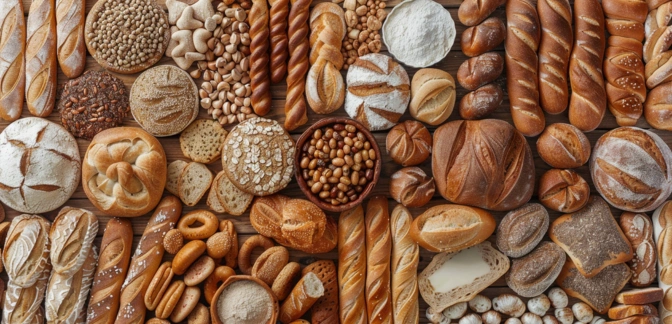Bagels — Nutrients, Health Benefits, And Shopping Tips

Written by Listonic Team
Last update on September 4, 2024
Nutrients
Nutrition facts
Amount per 100 g
Calories
🔥 250 kcal
| Nutrition per: 100 g | Value | % Daily Value* |
|---|---|---|
| Carbs | 49 g | 17.82% |
| Fiber | 2 g | 7.14% |
| Sugars | 5 g | 10% |
| Glycemic Index | 72 | - |
| Protein | 10 g | 20% |
| Sodium | 443 mg | 19.26% |
| Total Fat | 2 g | 2.56% |
*The % of Daily Value (DV) tells you how much a nutrient in a serving of food contributes to a daily diet. 2,000 calories a day is used for general nutrition advice.
10 g
🧀 Good Protein Content
2 g
🥕 Low Fat Content
Key takeaways
Health benefits
- Provides energy due to their high carbohydrate content, making them a good source of quick and sustained energy.
- Can be a source of whole grains if made with whole grain flour, which supports digestive health and provides essential nutrients.
- Rich in B vitamins, especially if fortified, which are important for energy metabolism and brain function.
- Contains protein, particularly when topped with protein-rich foods like eggs or smoked salmon.
Health risks
- High carbohydrate content which can lead to rapid blood sugar spikes, particularly concerning for diabetics or those on low-carb diets.
- Low nutrient density as most bagels are made from refined flour, lacking in essential nutrients and fiber.
- High calorie content which can contribute to weight gain, especially when bagels are large or topped with calorie-dense spreads.
- High sodium levels particularly in flavored or seasoned varieties, which can contribute to hypertension and increased cardiovascular risks.
How to choose bagels
Ideal bagels should have a dense, chewy interior with a glossy, slightly crisp crust. Look for bagels that are hand-shaped as this often denotes artisan quality. The aroma should be yeasty and inviting, promising a fresh, satisfying taste.
Steer clear of bagels that are too soft or lack a shiny crust, which can indicate they were not boiled prior to baking—a critical step for authentic texture. Bagels that appear overly dry or crumbly may have been overbaked or left out too long.

How to store bagels
To keep bagels fresh, store them in a paper bag at room temperature for up to two days. For longer storage, place them in a plastic bag and freeze. Frozen bagels can be thawed and toasted for a fresh taste.
Refrigeration is not ideal for bagels, as it can make them stale more quickly. Avoid leaving them in humid environments, which can cause mold growth. Slicing bagels before freezing can make it easier to defrost and toast just what you need.
✅ Extra Tip
How long do they last?
Bagels can last for 5-7 days at room temperature when stored in an airtight container or plastic bag. For longer storage, bagels can be frozen and kept for up to 6 months. Thaw at room temperature or toast directly from the freezer for the best results.
What to do with leftovers?
Leftover bagels can be enjoyed in several creative ways. Slice them and toast for a crisp bagel chip, perfect for dipping in hummus or cream cheese. You can also use bagel slices as a base for mini pizzas, topping them with sauce, cheese, and your favorite ingredients.
Turn leftover bagels into a bagel bread pudding by soaking them in a custard mixture and baking until golden. They can also be used to make bagel croutons for salads or soups. If you have plain bagels, try slicing and using them in a bagel breakfast sandwich, filled with eggs, bacon, and cheese. Bagels can also be repurposed into a savory or sweet bagel strata, layered with eggs, cheese, and vegetables or fruit.
👨⚕️️ Medical disclaimer
Discover products from other categories
Listonic Team
Fact-checked
Our editorial team checked this article to make sure it was accurate at the time of publishing it.
Get the top-rated shopping list app on your phone!







